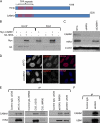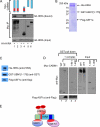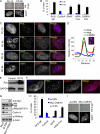Human CABIN1 is a functional member of the human HIRA/UBN1/ASF1a histone H3.3 chaperone complex
- PMID: 21807893
- PMCID: PMC3187368
- DOI: 10.1128/MCB.05546-11
Human CABIN1 is a functional member of the human HIRA/UBN1/ASF1a histone H3.3 chaperone complex
Abstract
The mammalian HIRA/UBN1/ASF1a complex is a histone chaperone complex that is conserved from yeast (Saccharomyces cerevisiae) to humans. This complex preferentially deposits the histone variant H3.3 into chromatin in a DNA replication-independent manner and is implicated in diverse chromatin regulatory events from gene activation to heterochromatinization. In yeast, the orthologous complex consists of three Hir proteins (Hir1p, Hir2p, and Hir3p), Hpc2p, and Asf1p. Yeast Hir3p has weak homology to CABIN1, a fourth member of the human complex, suggesting that Hir3p and CABIN1 may be orthologs. Here we show that HIRA and CABIN1 interact at ectopic and endogenous levels of expression in cells, and we isolate the quaternary HIRA/UBN1/CABIN1/ASF1a (HUCA) complex, assembled from recombinant proteins. Mutational analyses support the view that HIRA acts as a scaffold to bring together UBN1, ASF1a, and CABIN1 into a quaternary complex. We show that, like HIRA, UBN1, and ASF1a, CABIN1 is involved in heterochromatinization of the genome of senescent human cells. Moreover, in proliferating cells, HIRA and CABIN1 regulate overlapping sets of genes, and these genes are enriched in the histone variant H3.3. In sum, these data demonstrate that CABIN1 is a functional member of the human HUCA complex and so is the likely ortholog of yeast Hir3p.
Figures






Similar articles
-
Identification of an ubinuclein 1 region required for stability and function of the human HIRA/UBN1/CABIN1/ASF1a histone H3.3 chaperone complex.Biochemistry. 2012 Mar 27;51(12):2366-77. doi: 10.1021/bi300050b. Epub 2012 Mar 16. Biochemistry. 2012. PMID: 22401310 Free PMC article.
-
Human UBN1 is an ortholog of yeast Hpc2p and has an essential role in the HIRA/ASF1a chromatin-remodeling pathway in senescent cells.Mol Cell Biol. 2009 Feb;29(3):758-70. doi: 10.1128/MCB.01047-08. Epub 2008 Nov 24. Mol Cell Biol. 2009. PMID: 19029251 Free PMC article.
-
Placing the HIRA histone chaperone complex in the chromatin landscape.Cell Rep. 2013 Apr 25;3(4):1012-9. doi: 10.1016/j.celrep.2013.03.026. Epub 2013 Apr 18. Cell Rep. 2013. PMID: 23602572 Free PMC article.
-
A Molecular Prospective for HIRA Complex Assembly and H3.3-Specific Histone Chaperone Function.J Mol Biol. 2017 Jun 30;429(13):1924-1933. doi: 10.1016/j.jmb.2016.11.010. Epub 2016 Nov 19. J Mol Biol. 2017. PMID: 27871933 Free PMC article. Review.
-
Daxx and HIRA go viral - How chromatin remodeling complexes affect DNA virus infection.Tumour Virus Res. 2025 Jun;19:200317. doi: 10.1016/j.tvr.2025.200317. Epub 2025 Mar 20. Tumour Virus Res. 2025. PMID: 40120981 Review.
Cited by
-
Differential regulation of the histone chaperone HIRA during muscle cell differentiation by a phosphorylation switch.Exp Mol Med. 2016 Aug 12;48(8):e252. doi: 10.1038/emm.2016.68. Exp Mol Med. 2016. PMID: 27515126 Free PMC article.
-
The histone variant H3.3 claims its place in the crowded scene of epigenetics.Aging (Albany NY). 2017 Mar 10;9(3):602-614. doi: 10.18632/aging.101194. Aging (Albany NY). 2017. PMID: 28284043 Free PMC article. Review.
-
Profiling of transcriptional and epigenetic changes during directed endothelial differentiation of human embryonic stem cells identifies FOXA2 as a marker of early mesoderm commitment.Stem Cell Res Ther. 2013 Apr 24;4(2):36. doi: 10.1186/scrt192. Stem Cell Res Ther. 2013. PMID: 23618383 Free PMC article.
-
Transcription factor EKLF (KLF1) recruitment of the histone chaperone HIRA is essential for β-globin gene expression.Proc Natl Acad Sci U S A. 2014 Sep 16;111(37):13337-42. doi: 10.1073/pnas.1405422111. Epub 2014 Sep 2. Proc Natl Acad Sci U S A. 2014. PMID: 25197097 Free PMC article.
-
The longevity and reversibility of quiescence in Schizosaccharomyces pombe are dependent upon the HIRA histone chaperone.Cell Cycle. 2023 Sep;22(17):1921-1936. doi: 10.1080/15384101.2023.2249705. Epub 2023 Aug 27. Cell Cycle. 2023. PMID: 37635373 Free PMC article.
References
-
- Adams P. D. 2009. Healing and hurting: molecular mechanisms, functions, and pathologies of cellular senescence. Mol. Cell 36:2–14 - PubMed
Publication types
MeSH terms
Substances
Grants and funding
LinkOut - more resources
Full Text Sources
Molecular Biology Databases
